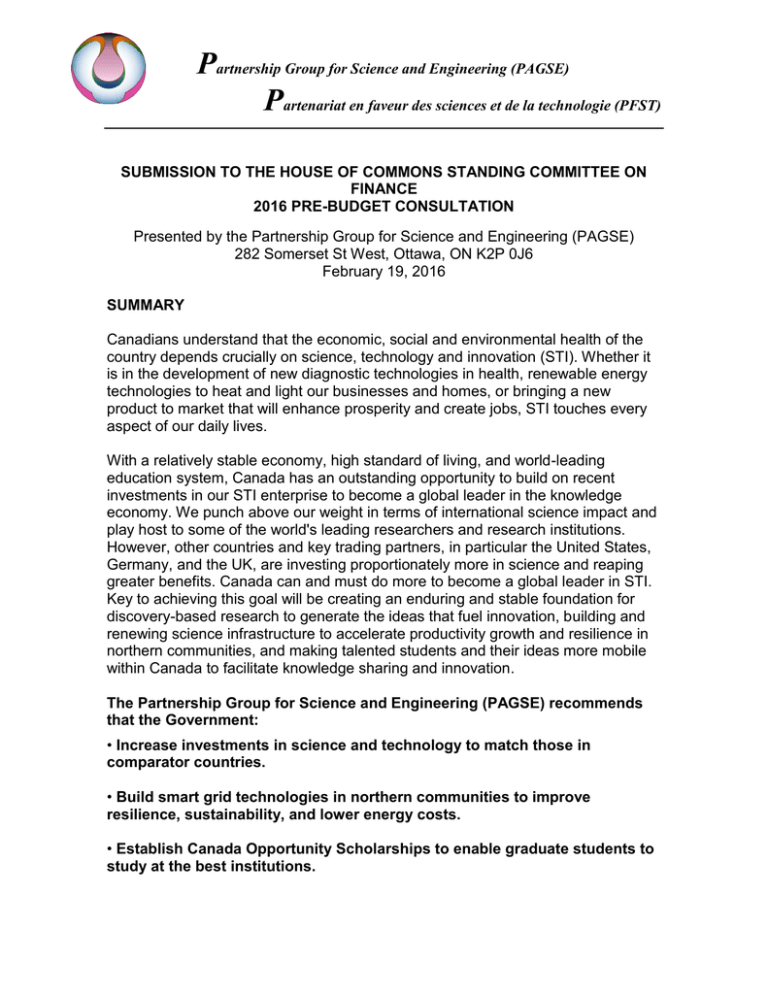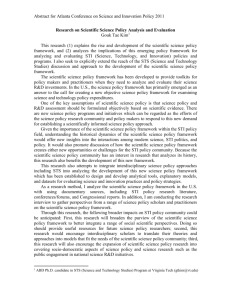Pdf version
advertisement

Partnership Group for Science and Engineering (PAGSE) Partenariat en faveur des sciences et de la technologie (PFST) SUBMISSION TO THE HOUSE OF COMMONS STANDING COMMITTEE ON FINANCE 2016 PRE-BUDGET CONSULTATION Presented by the Partnership Group for Science and Engineering (PAGSE) 282 Somerset St West, Ottawa, ON K2P 0J6 February 19, 2016 SUMMARY Canadians understand that the economic, social and environmental health of the country depends crucially on science, technology and innovation (STI). Whether it is in the development of new diagnostic technologies in health, renewable energy technologies to heat and light our businesses and homes, or bringing a new product to market that will enhance prosperity and create jobs, STI touches every aspect of our daily lives. With a relatively stable economy, high standard of living, and world-leading education system, Canada has an outstanding opportunity to build on recent investments in our STI enterprise to become a global leader in the knowledge economy. We punch above our weight in terms of international science impact and play host to some of the world's leading researchers and research institutions. However, other countries and key trading partners, in particular the United States, Germany, and the UK, are investing proportionately more in science and reaping greater benefits. Canada can and must do more to become a global leader in STI. Key to achieving this goal will be creating an enduring and stable foundation for discovery-based research to generate the ideas that fuel innovation, building and renewing science infrastructure to accelerate productivity growth and resilience in northern communities, and making talented students and their ideas more mobile within Canada to facilitate knowledge sharing and innovation. The Partnership Group for Science and Engineering (PAGSE) recommends that the Government: • Increase investments in science and technology to match those in comparator countries. • Build smart grid technologies in northern communities to improve resilience, sustainability, and lower energy costs. • Establish Canada Opportunity Scholarships to enable graduate students to study at the best institutions. • Provide tax credits for building and supporting new industry-partnered research laboratories across Canada. INTRODUCTION The Partnership Group for Science and Engineering (PAGSE) is an association of 24 professional and scientific organizations representing more than 50,000 members from academia, industry and government sectors. It represents the Canadian science and engineering community and seeks to advance research and innovation for the benefit of Canadians. PAGSE is best known for its flagship breakfast series of talks called Bacon and Eggheads. PAGSE presents a consensus statement based on consultations with its members. We seek to build on existing government programs and initiatives to strengthen the landscape for STI in our country. We concentrate on two themes: the upstream end of the innovation chain and the flexible development of innovation partnerships. A stable and enduring foundation for discovery-based research Our prosperity depends on our ability to translate the knowledge and ideas created by discovery-based research into innovations that improve economic productivity, either by cutting costs or creating new markets. While the path from idea to innovation is not always straight or even obvious, discovery research plays an essential role because it provides ideas that lead to innovation. Consider, as an example, the work of the late Dr. Michael Smith at the University of British Columbia. Dr. Smith was awarded the 1993 Nobel Prize in Chemistry for his “fundamental contributions to the establishment of oligonucleotide-based, sitedirected mutagenesis and its development for protein studies” (Nobelprize.org) or, in other words, his ability to manipulate DNA, the hereditary material for life, at will. His research was foundational and curiosity driven, without any direct connection to an applied problem. Yet this work now has a very innovative application: it helps produce human insulin, which keeps ~ 2.4 million Canadians and others with diabetes healthy and safe. Support for a vigorous discovery research environment is key to providing the ideas that fuel innovation. While recent investments in discovery research increasing funding for the Tri-Councils and creating the Canada Excellence Research Fund - are welcome, more needs to be done to ensure Canada remains globally competitive in supporting this key component of the STI system. Canada trails many OECD countries in support for Research and Development (R&D) funding as a percent of GDP. This gap is growing as Canada has slid from 16th to 23rd between 2006 and 2012 in terms of proportional R&D funding among OECD economies. During this time, spending as a proportion of GDP has dropped by 2 percent to 1.74per cent1. Notably, the Scientific Advisory Board of the Secretary General of the United Nations suggests R&D funding should be 3.5 per cent of 1 http://www.stic-csti.ca/eic/site/stic-csti.nsf/eng/00062.html#role GDP2. R&D funding at this level would place Canada in the enviable position of being a global leader in support for innovation. We encourage the Government of Canada to work toward committing 3.5 per cent of GDP to fund research and development by 2025. Developing renewable energy resources for Canada’s North Remote northern communities in Canada are not connected to the large electrical power grids available in the south. They operate as isolated micro grids supplying residential, business, and industrial customers. Most rely on diesel fuel to generate electricity, which is expensive to produce and transport. High electricity generation costs are passed on to Northerners. This problem is compounded by diesel generators’ substantial environmental footprint, which includes greenhouse gas and black carbon production in a region where climate change is occurring faster than nearly anywhere else on Earth. Renewable energy sources such as solar, wind, geothermal, and hydro power can help offset the impacts of diesel generation. Combinations of renewables can be tailored to each community's needs and local availability of the energy source. For example, Yukon and Northwest Territories have abundant hydro power potential, which are underused, in part, because energy storage technologies have not been deployed broadly. Smart grids work around this limitation by optimizing generation, delivery, and load of electricity. Federal leadership to support the construction and implementation of smart grids is critical as Territorial governments have insufficient resources to explore, test and deploy renewable energy options. The Federal government could set a target for investment in renewable energy in Northern communities to reduce the reliance on fossil fuels by about 20 per cent. Progress towards this target would improve energy efficiency, enhance reliability of energy supply, and reduce costs of living in the North. This change to northern infrastructure would also reduce greenhouse gas emissions, which would help meet emissions targets in the process, and facilitate new economic development by creating jobs and training opportunities in the North for civil, electrical, mechanical and environmental engineers. Funding emerging leaders in research and innovation Ideas that shape and re-shape the economy can come from anywhere in Canada or around the world. Yet, the people generating these game-changing ideas are often separated from the best training opportunities by great distances and an uneven playing field in terms of costs of study. PAGSE recommends creating a fund to help emerging leaders in research and innovation to contribute to Canada's economic evolution. For leading international students, the appeal of coming to Canada is the chance to work with world-leading researchers in top-flight institutions, but barriers associated with visa processing are reducing Canada's ability to attract the best and the 2 http://www.eurekalert.org/pub_releases/2015-07/tca-i3g070715.php brightest from the global talent pool3. The federal government can help increase Canada’s competitiveness for access to international talent in two ways. The first is by ensuring that visa processing times are competitive with key competitors, such as the USA and the UK, and that visa conditions facilitate stable progression of studies from undergraduate student to postdoctoral researcher. The second recommendation is to help equalize access and opportunity to education across Canada's regions, an effort that will benefit Canadian students as well as international ones. A Canada Opportunity Scholarship Program for Canadian permanent residents and international students would make it possible for the best students from any part of Canada to pursue research and innovation at the graduate level (MSc and PhD) anywhere else in Canada. Tuition fees vary significantly across Canada but costs of living vary dramatically. A student pursuing graduate work in plant biotechnology at the University of Saskatoon can expect to incur annual expenses of $15-$18k4. To pursue the same program at the University of British Columbia, a student living in a modest studio apartment might pay annual costs of $23k5. PAGSE recommends 1000 Canada Opportunity Scholarships of $5,000 be funded per year for two years of study for any advanced degree in science and technology, including graduate work in science, technology, engineering and mathematics (STEM) fields. The annual program costs in the first year would peak at $5 million per year and costs in subsequent years would then have an annual maximum of $10 million. Update the federal government Scientific Research and Experimental Development (SR&ED) Tax Credit Program The SR&ED program was created to encourage Canadian businesses of all sizes, in particular small to medium enterprises (SMEs) and start-up firms, and in all sectors of industry to conduct research and development (R&D) in Canada. It is among the most generous program of its kind in the world but concerns remain that Canada remains near the bottom of its peer group in terms of investment in innovation, at 13th out of 16 countries6. PAGSE recommends retargeting existing tax credits to operating costs that colocalize and embed industrial R&D facilities with universities and government research labs. Such joint facilities would complement existing programs that seek to encourage industry-academia partnerships such as those run by MITACS and NSERC. It also extends the potential impact of CFI infrastructure investments. This initiative would help unlock the wealth of ideas that can be ‘trapped’ within universities by providing a physical space to facilitate routine research-industry 3 http://www.theglobeandmail.com/news/national/ottawas-resource-gap-leaves-internationalstudents-waiting-for-visas/article24715563/ 4 http://explore.usask.ca/moneymatters/ 5 https://www.grad.ubc.ca/prospective-students/tuition-fees-cost-living/cost-living#calctable 6 http://www.conferenceboard.ca/hcp/details/innovation.aspx collaboration and encourage communication among researchers in different research fields from academia, government and industry. They would serve as science and engineering hubs for collaboration and attracting partners from Canada and around the world to draw upon the Canadian R&D capabilities and expertise. These innovation hubs could have the added value of making smaller universities attractive destinations for training, research, development and other related science and engineering activities. Funding for innovation projects and funding for hiring educated employees depends on a successful innovation ecosystem, in which incentives provided by an improved SR&ED tax credit program have an important role. CONCLUSION Canada’s federal government has a goal to enhance and assist innovation. There are clear opportunities to integrate innovation in northern development. Nevertheless, the science and engineering research community is unanimous that, over time, the erosion in support for basic research stifles the supply of ideas that drive innovation and the supply of young innovators from our universities. PAGSE urges the House of Commons Standing Committee on Finance to expand resources available for basic research.




